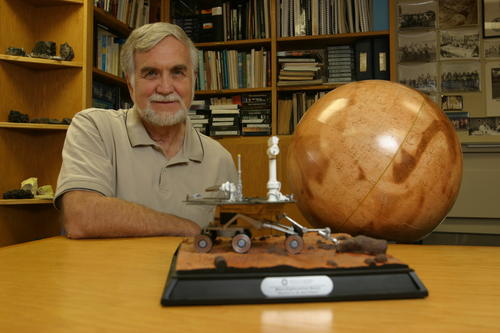Greeley – major crater pays tribute to a leading planetary scientist
» Read more about the impact crater and the person Ronald Greeley
In 2015 the International Astronomical Union (IAU) named the impact crater shown in this image mosaic from the High Resolution Stereo Camera (HRSC) after the US scientist Ronald Greeley, who passed away in 2011. Greeley was a pioneer in the field of planetary geology, which he taught and researched at Arizona State University from 1977 onwards. From the very outset, in 1988, Greeley was also a member of the HRSC experiment team –first on the unsuccessful Russian mission Mars 96 and then on the follow-up Mars Express mission, operated by the European Space Agency (ESA).
Greeley Impact Crater is located in Noachis Terra, an area of the southern highlands between the Argyre and Hellas Planitia impact basins and, with a diameter of 427 kilometres, is one of the largest impact craters on Mars. This ancient crater, which has already been heavily eroded and filled with sediment, is difficult to make out against the Martian landscape due to its relatively shallow depth of only 1.5 kilometres – indeed, the crater rim has disappeared altogether in places. An astronaut standing in the middle of the crater would not be able to see the crater rim on the horizon at all due to the curvature of Mars, which is greater than Earth’s. The crater outline is most visible on the colour-coded digital terrain model.
With an age of up to four billion years, Noachis Terra is one of Mars’ oldest regions. Countless impact craters of different sizes were formed and later eroded here over the course of billions of years. Through these erosion processes, impact craters that had once been trough-shaped were worn away over time by wind, water or ice into shallow depressions devoid of relief. The lack of ejected material, the low and partially non-existent crater rim, the flat crater floor and the numerous impact craters within it indicate that Greeley Crater is very old. A closer look reveals a myriad of tiny craters here and there. Known as secondary craters, these are a result of the impact of material ejected when other objects hit the planet’s surface. Small, narrow gullies cross some of the larger inner craters, indicating that water once flowed within the crater. Other wider channels suggest that masses of ice loaded with sediment once crept down the slopes. The different colouration of the material on the crater floor is due to the differences in composition – the lighter material was weathered through water and the darker surfaces covered by volcanic sands.
Ronald Greeley’s passion was Mars science. Not only was he a co-investigator for the Mars Express HRSC, but he was also involved in other Mars missions, such as Mariner, Viking, Pathfinder, Mars Global Surveyor and the Mars Exploration Rovers Spirit and Opportunity. His career in planetary research began in 1967 at NASA AMES Research Center, where he studied volcanic landforms and lava tubes on Earth and the Moon. He later worked with planetary mission data acquired by Galileo for Jupiter, Magellan for Venus, and Voyager 2 for Uranus and Neptune. He was also interested in surface features and processes that occur due to the effects of wind on other planets. In 1977 he became Professor of the School of Earth and Space Exploration at Arizona State University, where he created the Planetary Aeolian Laboratory, which is still running to this day. Atmospheric processes on planets were researched in closer detail here using a wind tunnel and a device that could generate vortex motion.
Ronald Greeley passed away on 27 October 2011 as an internationally renowned and distinguished scientist. In 2015 the International Astronomical Union (IAU) named this Martian crater in his honour. Further, the Ronald Greeley Center Center for Planetary Studies (RGCPS), at Arizona State University, Tempe, is one in a network of 16 Regional Planetary Image Facility (RPIF) data centers, established by NASA to archive planetary images for use by the scientific and educational communities. The RGCPS began as the Space Photography Laboratory (SPL), established by Dr. Ronald Greeley when he moved from the NASA-Ames Research Center to Arizona State University in 1977. Prof. Ronald Greeley was the Director of the SPL until he passed away in 2011. Prof. David A. Williams is the current director of the facility, which has since been renamed the Ronald Greeley Center for Planetary Studies.
“Ron Greeley’s colleagues at Arizona State University are so honored with this HRSC product of Greeley Crater on Mars,” said Dr. David Williams, Associate Research Professor in ASU’s School of Earth and Space Exploration and an HRSC Co-Investigator. “We even have a rendition of this HRSC mosaic of Greeley Crater in our newly-renovated Ronald Greeley Center for Planetary Studies, the NASA Regional Planetary Information Facility at ASU”.
